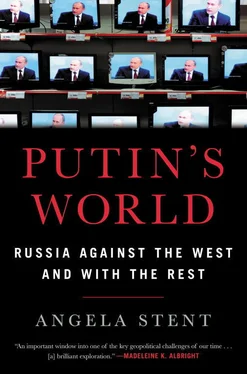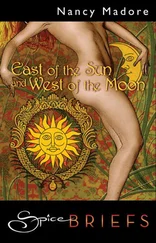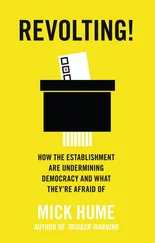But it did not last long. US and Russian expectations from this partnership were mismatched, and this became clear after the initial rout of the Taliban. Putin, according to one Russian observer, wanted an “equal partnership of unequals” from the United States. For him, that would have meant US recognition that Russia had a legitimate right to a sphere of influence in the post-Soviet space. There should be no prospect of further NATO enlargement, and the US should refrain from democracy promotion that might bring to power anti-Russia governments in the post-Soviet states. Putin often repeats the same catalogue of grievances to his interlocutors: in 2002 the United States withdrew unilaterally from the Anti-Ballistic Missile Treaty—one of the pillars of US-Soviet arms control—in order to proceed with missile defense; it supported color revolutions in Georgia and Ukraine; it invaded Iraq and pursued a global Freedom Agenda deemed hostile to Moscow; the Baltic states joined NATO; and the Bush administration unsuccessfully sought to persuade NATO to offer membership to Ukraine and Georgia. And Vice President Dick Cheney became increasingly vocal in his criticism of repression in Russia and of the Kremlin’s attempts to intimidate its neighbors. Putin’s frustration erupted at the Munich Security Conference. The second reset was over.
Although he paid a visit to the Bush compound in Kennebunkport, Maine, later that year for an informal “lobster summit,” Putin’s view of the United States had irreversibly soured. In 2008, he became prime minister, following the law that permitted only two consecutive terms as president, and installed his protégé Dmitry Medvedev as president. Nevertheless, he continued to run Russia. In August 2008, the Russia-Georgia War brought US-Russia relations to an even lower ebb with Washington cutting off all bilateral contacts above the level of deputy assistant secretary. During the 2008 US election campaign, criticism of Russia featured prominently.
THE MEDVEDEV INTERLUDE
When Dmitry Medvedev became president, the outside world was intrigued, puzzling over how this new Kremlin “tandem” would work. Would Medvedev really be Putin’s successor and a de facto, as opposed to de jure, president? Dozens of hours were spent in US government offices and Washington think tanks analyzing how the Putin-Medvedev dynamic was working. All that effort could have been spared. By the time Medvedev and Putin swapped places in 2012, there was no doubt that Putin had been in charge all along, a reality the Obama administration was slow to recognize. But that was not evident in 2008, and for a while, Medvedev appeared to have Putin’s blessing to reach out to the United States and seek to improve ties.
He found a receptive partner in Barack Obama. The new US president came to office offering a reset with Russia. His vice president, Joe Biden, announced the new US policy at the Munich Security Conference in February 2009, two years after Putin’s attack on the US: “The last few years have seen a dangerous drift in relations between Russia and the members of our Alliance…. it’s time to press the reset button and to revisit the many areas where we can and should be working together with Russia.” 25Obama himself experienced the difference between Putin and Medvedev when he made his first visit to Russia in July 2009. Meeting with Putin, he asked, “How did we get into this mess?” Putin then delivered a ninety-minute monologue cataloging all his grievances against the United States with Obama sitting awkwardly in a chair that was too small for his tall frame. This first encounter set the stage for what was to remain a wary relationship between the two leaders. By contrast, the Obama and Medvedev families enjoyed a cordial dinner together, and the two presidents, both from a post–Cold War generation, developed a good working relationship. The next year Medvedev visited the United States, opened his own Twitter account in Silicon Valley, and dined on gourmet hamburgers with Obama at the latter’s favorite fast-food restaurant in suburban Virginia. 26Immediately after Medvedev left, the FBI arrested ten “sleeper spies” who had been operating in the United States and sent them back to Russia, without any measurable damage to the relationship. 27
The first Obama term and Medvedev’s only term in the Kremlin were optimistic and productive years for the US-Russia relationship, at least for the first two and a half years. The reset produced concrete results: a New Strategic Arms Reduction Treaty (New START); cooperation to curb Iran’s nuclear program by imposing tougher sanctions; cooperation on the Northern Distribution Network carrying NATO troops and materiel to and from Afghanistan over Russian territory; the establishment of a Bilateral Presidential Committee designed to advance the relationship over a broad front; and Russia’s accession to the World Trade Organization (WTO) after nineteen years of negotiations. The Obama administration somewhat retreated from the Bush-era focus on the post-Soviet space. But the US and Russia came no closer to agreeing on their respective roles in Russia’s neighborhood. Despite intense discussions on developing a cooperative approach toward missile defense, Washington and Moscow were unable to agree, and the US missile defense program remained a contentious issue. Russia insisted that US missile defenses were aimed at Russia, not at Iran, as the United States claimed. Moreover, although during Medvedev’s term there was somewhat greater room for domestic discussion of difficult issues, the United States continued to criticize Russia’s democratic deficits.
Obama administration officials had initially believed—erroneously, it turned out—that they could “empower” Medvedev to strengthen his position against that of Putin. Although Putin had been willing to allow Medvedev to act as the more liberal leader who engaged with America, it transpired that there were limits to what he would tolerate. Medvedev’s support for a UN resolution that ultimately led to Muammar Gaddafi’s brutal demise was apparently one of the factors that influenced Putin’s decision to end this four-year experiment in closer ties with the US through the tandem leadership. And that was the beginning of the end of the reset.
In September 2011, US-Russia relations received a sudden jolt. Putin announced that he and Medvedev would swap places, and he would return to the Kremlin in the following year. Tens of thousands of outraged Muscovites, resenting the fact that the Russian people would have no say in deciding who would govern them, took to the streets in December 2011 to protest what they believed were falsified Duma election results and demanded that Putin go. Shocked by this unexpected opposition to his rule, Putin immediately blamed the United States, and specifically Secretary of State Hillary Clinton, for financing the protests. Clinton had expressed “serious concern about the conduct of the elections” and called for a “full investigation of all reports of fraud and intimidation.” 28Putin was outraged. Clinton, said Putin, had sent “a signal” to “some actors in our country…. They heard the signal and with the support of the US State Department began active work.” 29Putin’s personal animus against Clinton dates back at least to December 2011, as does his belief that the United States interfered in the 2012 Russian presidential election by financing and supporting his opponents. This was hardly an auspicious way to inaugurate the next phase of US-Russia relations as Putin began his third term.
PUTIN REDUX AND THE END OF THE RESET
From the Obama administration’s perspective, once Putin was back in the Kremlin, the Russian side appeared disinterested in renewing the relationship and did not respond to overtures to establish an agenda for dialogue. Perhaps Putin was awaiting the results of the 2012 US presidential election. Once Obama was reelected, however, things took a turn for the worse. Russia had entered the WTO in 2012, but the price Congress extracted for granting Russia permanent normal trading status was the Magnitsky Act, a piece of legislation that sanctioned Russian officials complicit both in the death in prison of Russian lawyer Sergei Magnitsky and more generally in human rights violations. In retaliation, Russia ended US adoptions of Russian children. The crisis in Syria, discussed in a previous chapter, placed extra strains on the relationship. But the fissure turned into a great chasm when Edward Snowden, a disgruntled contractor for the National Security Agency, arrived in Moscow from Hong Kong, carrying millions of stolen top-secret files detailing US intelligence operations at home and abroad. The US demanded that Russia return him to the United States. Putin seized the opportunity to turn the tables. He declared that Snowden was a “new dissident” and granted him political asylum in Russia as a “humanitarian” gesture. 30The US reaction was swift. Obama cancelled a bilateral summit he was to have had with Putin, the first time such a cancellation had happened since 1960. He went on to describe Putin’s demeanor this way: “He’s got that kind of slouch, looking like the bored kid in the back of the classroom.” 31He dismissed Russia as a “regional power” and called for a “pause” in the relationship. 32Later that year, reacting to a televised address Obama had given, Putin criticized the idea of American exceptionalism in his op-ed in the New York Times : “It is extremely dangerous to encourage people to see themselves as exceptional, whatever the motivation.” 33
Читать дальше












